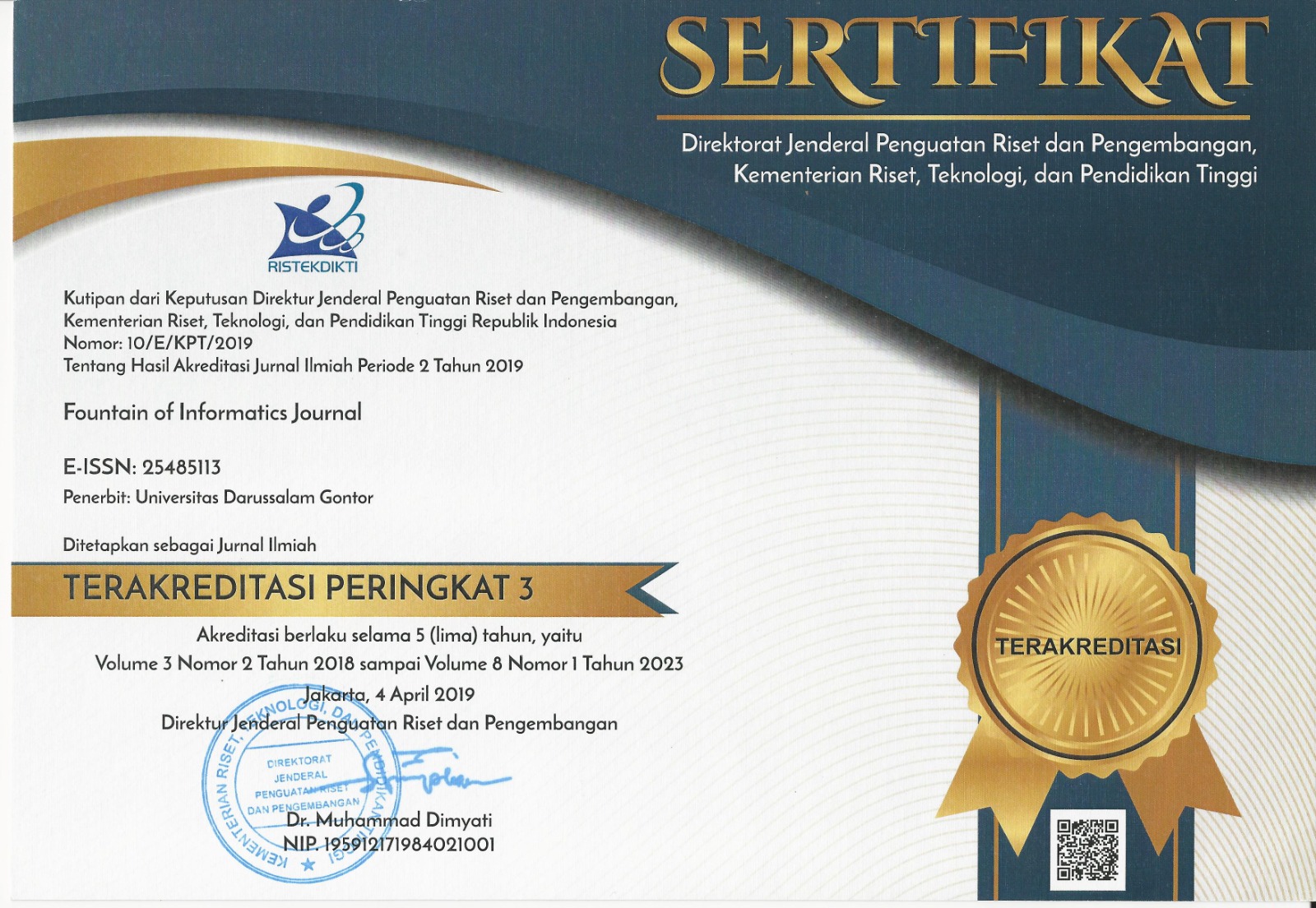Prediksi Harga Minyak Dunia Dengan Metode Deep Learning
DOI:
https://doi.org/10.21111/fij.v6i1.4446Keywords:
LSTM, deep learning, peramalan, harga minyakAbstract
AbstrakPeramalan seri waktu mendapatkan banyak perhatian dari berbagai penelitian. Salah satu data seri waktu yang barubah setiap periode tertentu adalah minyak bumi. Secara umum harga minyak bumi dipengarui oleh dua hal yaitu permintaan dan pendapatan. Pada penelitian ini menggunakan state-of-the-art model Deep Learning LSTM (Long Short Term Memory) untuk meramalkan harga minyak dalam periode tertentu. Metode ini digunakan karena arsitekturnya dapat beradaptasi dengan belajar non-linear dari data seri waktu yang kompleks. Dataset yang digunakan adalah data Brent Oil Price yang selalu di update setiap minggu. Dataset ini berisi harga minyak brent dari tahun 1987 sampai sekarang. Beberapa model yang dibangun terbukti dapat meramalkan harga minyak dengan baik. Model terbaik yang didapatkan dari penelitian ini memiliki RMSE 0,0186 dan MAE 0,013.Kata kunci: LSTM, deep learning, peramalan, harga minyak Abstract[Forecasting World Oil Price with Deep Learning Method] Time series forecasting gets a lot of attention from various studies. One of the time-series data that changes every certain period is petroleum. In general, the price of petroleum is affected by two things, namely demand and income. This research uses a state-of-the-art Deep Learning LSTM (Long Short-Term Memory) model to predict the oil price in a certain period. This method is used because the architecture can adapt to non-linear learning from complex time series data. The dataset used is the Brent Oil Price data, which is always updated every week. This dataset contains the price of Brent oil from 1987 to the present. The models that were built proved to be able to predict oil prices well. The best models obtained from this study have RMSE 0.0186 and MAE 0.013.Keywords: LSTM, deep learning, forecasting, oil priceReferences
[1] P. Ponadi, D. Amboningtyas, and A. Fathoni, “ANALYSIS OF THE EFFECT OF WORLD OIL PRICE INCREASE, AMOUNT OF CIRCULAR MONEY, AND EXCHANGE ON INFLATION IN INDONESIA (Case Study of Mining Companies in the 2013-2017 Period),†J. Manage., vol. 5, no. 5, 2019.[2] A. Sagheer and M. Kotb, “Time series forecasting of petroleum production using deep LSTM recurrent networks,†Neurocomputing, vol. 323, pp. 203–213, 2019.[3] M. R. Mahdiani and E. Khamehchi, “A modified neural network model for predicting the crude oil price,†Intellect. Econ., vol. 10, no. 2, pp. 71–77, 2016, doi: 10.1016/j.intele.2017.02.001.[4] J. Wang and J. Wang, “Forecasting energy market indices with recurrent neural networks: Case study of crude oil price fluctuations,†Energy, vol. 102, pp. 365–374, 2016.[5] L. Yu, X. Zhang, and S. Wang, “Assessing potentiality of support vector machine method in crude oil price forecasting,†Eurasia J. Math. Sci. Technol. Educ., vol. 13, no. 12, pp. 7893–7904, 2017, doi: 10.12973/ejmste/77926.[6] M. Abusalah, “Brent Oil Price,†2020. https://www.kaggle.com/mabusalah/brent-oil-prices (accessed Mar. 20, 2020).[7] S. Jain, S. Shukla, and R. Wadhvani, “Dynamic selection of normalization techniques using data complexity measures,†Expert Syst. Appl., vol. 106, pp. 252–262, 2018.[8] Scikit-learn.org, “6.3. Preprocessing Data — Scikit-Learn 0.23.1 Documentation,†2020. https://scikit-learn.org/stable/modules/preprocessing.html (accessed Mar. 23, 2020).[9] S. Hochreiter and J. Schmidhuber, “Long short-term memory,†Neural Comput., vol. 9, no. 8, pp. 1735–1780, 1997.[10] Y. Sudriani, I. Ridwansyah, and H. A. Rustini, “Long short term memory (LSTM) recurrent neural network (RNN) for discharge level prediction and forecast in Cimandiri river, Indonesia,†in IOP Conference Series: Earth and Environmental Science, 2019, vol. 299, no. 1, p. 12037.[11] A. G. Salman, Y. Heryadi, E. Abdurahman, and W. Suparta, “Single layer & multi-layer long short-term memory (LSTM) model with intermediate variables for weather forecasting,†Procedia Comput. Sci., vol. 135, pp. 89–98, 2018.[12] V. K. R. Chimmula and L. Zhang, “Time Series Forecasting of COVID-19 transmission in Canada Using LSTM Networks,†Chaos, Solitons & Fractals, p. 109864, 2020.[13] Y. Ding, Y. Zhu, J. Feng, P. Zhang, and Z. Cheng, “Interpretable Spatio-Temporal Attention LSTM Model for Flood Forecasting,†Neurocomputing, 2020.[14] S. Muzaffar and A. Afshari, “Short-term load forecasts using LSTM networks,†Energy Procedia, vol. 158, pp. 2922–2927, 2019.[15] M. Zaheer, S. Reddi, D. Sachan, S. Kale, and S. Kumar, “Adaptive methods for nonconvex optimization,†in Advances in neural information processing systems, 2018, pp. 9793–9803.
Downloads
Submitted
Accepted
Published
Issue
Section
License
Please find the rights and licenses in the Fountain of Informatics Journal (FIJ). By submitting the article/manuscript of the article, the author(s) agree with this policy. No specific document sign-off is required.
1. License
The non-commercial use of the article will be governed by the Creative Commons Attribution license as currently displayed on Creative Commons Attribution-NonCommercial-ShareAlike 4.0 International License.Â
2. Author(s)' Warranties
The author warrants that the article is original, written by the stated author(s), has not been published before, contains no unlawful statements, does not infringe the rights of others, is subject to copyright that is vested exclusively in the author, and free of any third party rights, and that any necessary written permissions to quote from other sources have been obtained by the author(s).
3. User/Public Rights
FIJ's spirit is to disseminate articles published are as free as possible. Under the Creative Commons license, FIJ permits users to copy, distribute, display, and perform the work for non-commercial purposes only. Users will also need to attribute authors and FIJ on distributing works in the journal and other media of publications. Unless otherwise stated, the authors are public entities as soon as their articles got published.Â
4. Rights of Authors
Authors retain all their rights to the published works, such as (but not limited to) the following rights;
- Copyright and other proprietary rights relating to the article, such as patent rights,
- The right to use the substance of the article in own future works, including lectures and books,
- The right to reproduce the article for own purposes,
- The right to self-archive the article (please read out deposit policy),
- The right to enter into separate, additional contractual arrangements for the non-exclusive distribution of the article's published version (e.g., post it to an institutional repository or publish it in a book), with an acknowledgment of its initial publication in this journal (Jurnal Optimasi Sistem Industri).
5. Co-Authorship
If the article was jointly prepared by more than one author, any authors submitting the manuscript warrants that he/she has been authorized by all co-authors to be agreed on this copyright and license notice (agreement) on their behalf, and agrees to inform his/her co-authors of the terms of this policy. FIJ will not be held liable for anything that may arise due to the author(s) internal dispute. FIJ will only communicate with the corresponding author.
6. Royalties
Being an open accessed journal and disseminating articles for free under the Creative Commons license term mentioned, author(s) aware that FIJ entitles the author(s) to no royalties or other fees.Â
7. Miscellaneous
FIJ will publish the article (or have it published) in the journal if the article’s editorial process is successfully completed. FIJ's editors may modify the article to a style of punctuation, spelling, capitalization, referencing, and usage that deems appropriate. The author acknowledges that the article may be published so that it will be publicly accessible and such access will be free of charge for the readers as mentioned in point 3.










